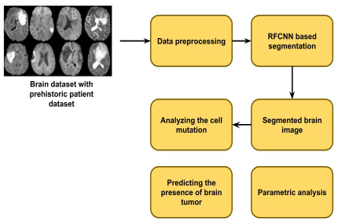Classification Based Detection of Brain Cells Mutation using Deep Learning Architecture with IoT in Smart Healthcare Application
Keywords:
brain tumor, MRI tumor, segmentation, Reg_FConVolNN, classification accuracyAbstract
The formation of a brain tumour involves a collection of tissue to which abnormal cells are gradually added. The most difficult duty is to categorise brain tumours using magnetic resonance imaging (MRI) so that affected people can receive therapy. Typically, human investigators examine brain MRI scans for tumour identification and categorization. According to the classification, for which various methodologies are created, images are interpreted. Brain tumour MRI segmentation utilising the suggested Reg FConVolNN segmentation method yields information about anatomical patterns and aberrant tissues. Here, a dataset of patients who had previously experienced brain tumour symptoms was combined with their historical medical information. The suggested neural technique can analyse MRI pictures to find cell mutations and pre-process input images to remove components like the vertebral column or skull in preparation. The effectiveness of the strategy suggested utilising a dataset of MRI images is contrasted with that of existing deep learning and machine learning models. The results show that the suggested method outperformed methods that employed the same dataset in terms of accuracy, AUC, precision, recall, and F-1 score for tumour classification.
Downloads
References
Md. Rezwanul Islam , Md. Rizwan Imtiaz, Marium-E-Jannat, Detection and analysis of brain tumor from MRI by Integrated Thresholding and Morphological Process with Histogram based method , IEEE 2018
HarshiniBadisa, Madhavi Polireddy, Aslam Mohammed, CNN Based Brain Tumor Detection , ISSN: 2249 – 8958, 8 (4), April 2019
Bashayer Fouad Marghalani, Muhammad Arif, Automatic Classification of Brain Tumor and Alzheimer's Disease in MRI ,2019
J. Seetha and S. Selvakumar Raja,Brain Tumor Classification Using Convolutional Neural Networks, 11(3), p. 1457-1461,2018
Rachapudi, V., Lavanya Devi, G. Improved convolutional neural network based histopathological image classification. Evol. Intel. (2020). https://doi.org/10.1007/s12065-02000367-y
Krishnaraj, V., Jaisharma, K., & Deepa, N. (2019). Real time briantumor detection using deep reinforcement learning algorithm. Test Engineering and Management, 81(11-12), 5370-5379. Retrieved from www.scopus.com.
Kurade, M., Nakil, N., Pai, S., Ringane, V., & Akulwar, P. K. A Survey on Brain Tumor Detection using Machine Learning.
Kang, J., Ullah, Z., & Gwak, J. (2021). MRI-Based Brain Tumor Classification Using Ensemble of Deep Features and Machine Learning Classifiers. Sensors, 21(6), 2222.
Sharif, M. I., Li, J. P., Naz, J., & Rashid, I. (2020). A comprehensive review on multi-organs tumor detection based on machine learning. Pattern Recognition Letters, 131, 30-37.
Amin, J., Sharif, M., Raza, M., & Yasmin, M. (2018). Detection of brain tumor based on features fusion and machine learning. Journal of Ambient Intelligence and Humanized Computing, 1-17.
Tarik, H., Tawfik, M., Youssef, D., Simohammed, S., Mohammed, O. J., & El Miloud, J. (2019, November). Towards an improved CNN architecture for brain tumor classification. In International Conference Europe Middle East & North Africa Information Systems and Technologies to Support Learning (pp. 224-234). Springer, Cham.
Garg, S., & Bhagyashree, S. R. (2019, February). Detection and Classification of Tumors Using Medical Imaging Techniques: A Survey. In Intelligent Communication Technologies and Virtual Mobile Networks (pp. 363-372). Springer, Cham.

Downloads
Published
How to Cite
Issue
Section
License

This work is licensed under a Creative Commons Attribution-ShareAlike 4.0 International License.
All papers should be submitted electronically. All submitted manuscripts must be original work that is not under submission at another journal or under consideration for publication in another form, such as a monograph or chapter of a book. Authors of submitted papers are obligated not to submit their paper for publication elsewhere until an editorial decision is rendered on their submission. Further, authors of accepted papers are prohibited from publishing the results in other publications that appear before the paper is published in the Journal unless they receive approval for doing so from the Editor-In-Chief.
IJISAE open access articles are licensed under a Creative Commons Attribution-ShareAlike 4.0 International License. This license lets the audience to give appropriate credit, provide a link to the license, and indicate if changes were made and if they remix, transform, or build upon the material, they must distribute contributions under the same license as the original.





